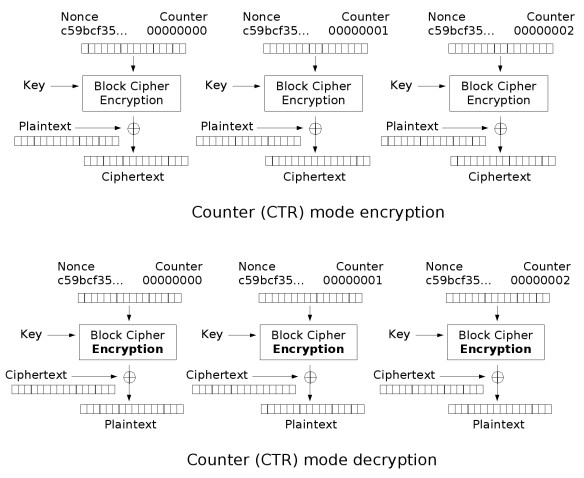AES CBC/CTR 加解密原理
So, lets look at how CBC works first. The following picture shows the encryption when using CBC (in this case, using AES as the cipher).

Basically, Cipher-Block-Chaining means that previous to putting the cleartext data block into the cipher itself (AES, DES, Triple-DES, …) it is XORed with the previous cipher block. This works fine for all but the first cleartext block, as – of course – there is no previous cipher block. So, the encrypting entity chooses a random value of block size (8bytes for DES, 16bytes for AES) to use in the first XOR. This value is the so-called Initialization Vector or IV. The following picture depicts the decryption using CBC.

Basically, the decryption works very similarily to encryption. This time, the ciphertext block is put through the decryption routine and is then XORed with the previous ciphertext block. Also, for the first block, we use the IV again. The important thing to understand at this point is the following. If, for some reason, we can deduce what comes out of the AES block in the first cipher (what is denoted here as the Intermediary Message (IM)), we can produce any “plain text” we want. Why can we do that? Well, CBC uses the IV to XOR the IM and we usually control this. So, for each byte of message we want to “generate”, we choose the IV as follows:
IV[n] = IM[n] ^ DesiredMessage[n]
If you wonder how you might deduce the IM, look up “padding oracles” on Google.
As both DES and AES are block ciphers, the length of the given input must always be a multiple of the block size. As messages might not fit this condition, the plaintext is padded to a multiple of block size. However, the decrypting entity must somehow know, how much padding was append to the original cleartext. There a multiple ways of doing this, we will focus on PKCS5 as it was needed in this challenge.
PKCS5 encodes a padding of n bytes by filling the all of the padded “slots” with n. Basically, if we have only one byte padding, the last byte will be 1. If we have e.g. 5 bytes padding, the last 5 bytes will all be set to 5. Please note, that padding must always be provided. Thus, if the message actually had a length which was a multiple of the block size, there will be exactly one block added to the message. For 8byte ciphers like DES, we then have a block of length 8b filled completely with 8s.
AES CBC加解密原理
CBC加解密原理如下图所示, 图片来源维基百科

CBC加密原理:明文跟向量异或,再用KEY进行加密,结果作为下个BLOCK的初始化向量。解密原理:使用密钥先对密文解密,解密后再同初始向量异或得到明文。
CBC需要对明文块大小进行Padding(补位),由于前后加密的相关性,只能实施串行化动作,无法并行运算。另外,CBC需要参量:密钥和初始化向量。
AES CTR加解密原理

CTR加密原理:用密钥对输入的计数器加密,然后同明文异或得到密文。解密原理:用密钥对输入计数器加密,然后同密文异或得到明文。
CTR不需要Padding,而且采用了流密钥方式加解密,适合于并行运算,CTR涉及参量:Nounce随机数、Counter计数器和密钥。Nounce随机数和Counter计数器整体可看作计数器,因为只要算法约定好,就可以回避掉串行化运算。
参考资料:
http://zh.wikipedia.org/wiki/高级加密标准
http://zh.wikipedia.org/zh/块密码的工作模式
AES CBC/CTR 加解密原理的更多相关文章
- Java 使用AES/CBC/PKCS7Padding 加解密字符串
介于java 不支持PKCS7Padding,只支持PKCS5Padding 但是PKCS7Padding 和 PKCS5Padding 没有什么区别要实现在java端用PKCS7Padding填充, ...
- python 实现 AES CBC模式加解密
AES加密方式有五种:ECB, CBC, CTR, CFB, OFB 从安全性角度推荐CBC加密方法,本文介绍了CBC,ECB两种加密方法的python实现 python 在 Windows下使用AE ...
- JAVA AES CBC PKCS5Padding加解密
package com.hzxc.groupactivity.util; /** * Created by hdwang on 2019/1/17. */ import org.slf4j.Logge ...
- C++ 和 java 使用 AES CBC 128 加解密
Java 使用jce, code: import javax.crypto.Cipher; import javax.crypto.spec.IvParameterSpec; import javax ...
- openssl:AES CBC PKCS5 加解密 (C/GOLANG)
#include <openssl/aes.h> /* AES_CBC_PKCS5_Encrypt * 入参: * src:明文 * srcLen:明文长度 * key:密钥 长度只能是1 ...
- 手机号的 AES/CBC/PKCS7Padding 加解密
前言:接口中上次的手机号码和密码是传入的加密的,模拟自动化的时候也需要先对数据进行加密 1.各种语言实现 网上已经各种语言实现好的AES加密,可以点击查看:http://outofmemory.cn/ ...
- node.js 实现 AES CTR 加解密
node.js 实现 AES CTR 加解密 node aesctr 前言 由于最近我们在做一款安全的文件分享 App, 所有文件均需要使用 aes ctr 来进行加密,aes key 还有一整套完整 ...
- python 实现 AES ECB模式加解密
AES ECB模式加解密使用cryptopp完成AES的ECB模式进行加解密. AES加密数据块分组长度必须为128比特,密钥长度可以是128比特.192比特.256比特中的任意一个.(8比特 == ...
- Spring Boot 实现配置文件加解密原理
Spring Boot 配置文件加解密原理就这么简单 背景 接上文<失踪人口回归,mybatis-plus 3.3.2 发布>[1] ,提供了一个非常实用的功能 「数据安全保护」 功能,不 ...
随机推荐
- Linux - awk 文本处理工具五
awk 线上处理常用模式 awk 处理复杂日志 6.19: DHB_014_号百总机服务业务日报:广州 到达数异常! DHB_023_号百漏话提醒日报:珠海 到达数异常! 6.20: DHB_014_ ...
- python中的__getattr__、__getattribute__、__setattr__、__delattr__、__dir__
__getattr__: 属性查找失败后,解释器会调用 __getattr__ 方法. class TmpTest: def __init__(self): self.tmp = 'tmp12 ...
- 前端学PHP之正则表达式函数
前面的话 正则表达式不能独立使用,它只是一种用来定义字符串的规则模式,必须在相应的正则表达式函数中应用,才能实现对字符串的匹配.查找.替换及分割等操作.前面介绍了正则表达式的基础语法,本文将详细介绍正 ...
- Servlet笔记10--Session
Web编程中的Session: 代码示例: package com.bjpowernode.javaweb.servlet; import java.io.IOException; import ja ...
- PHP中冒号、endif、endwhile、endfor使用介绍
我们经常在wordpress一类博客程序的模板里面看到很多奇怪的PHP语法,比如: 复制代码代码如下: <?php if(empty($GET_['a'])): ?> <font c ...
- [转]如何取得当前正在执行的shell脚本的绝对路径?
来源:http://sexywp.com/bash-how-to-get-the-basepath-of-current-running-script.htm 如题,一般我们写Shell脚本的时候,都 ...
- darknet
darknet第二作者:https://github.com//AlexeyAB/darknet#how-to-train-to-detect-your-custom-objects yolov3实现 ...
- linux诡异的硬盘不足
phpmyadmin页面登录不进去,ftp也连不上.而服务端的service都开着的.直觉是看一下硬盘使用情况. df -TH 发现可用空间几乎为0 但是查看各个目录使用情况: du -sh /* | ...
- #JS 获取屏幕分辨率、网页可见区域等
window.screen document.body <script type="text/javascript"> function getInfo(){ var ...
- mysql 事务隔离级别 详解
问题 在工作中真实遇到的问题:用python连接mysql,查询数据,同时有别的代码在更新mysql中的数据,前者是一直是保持连接的数据库,每一分钟select一次,但第二次却查不到更新后的数据?wh ...
